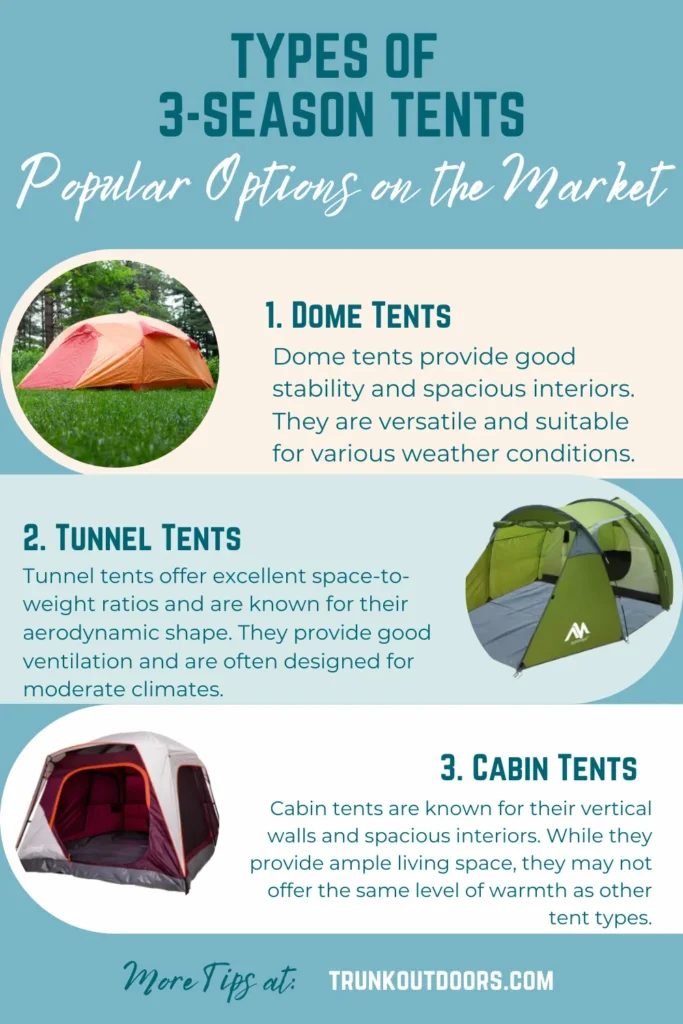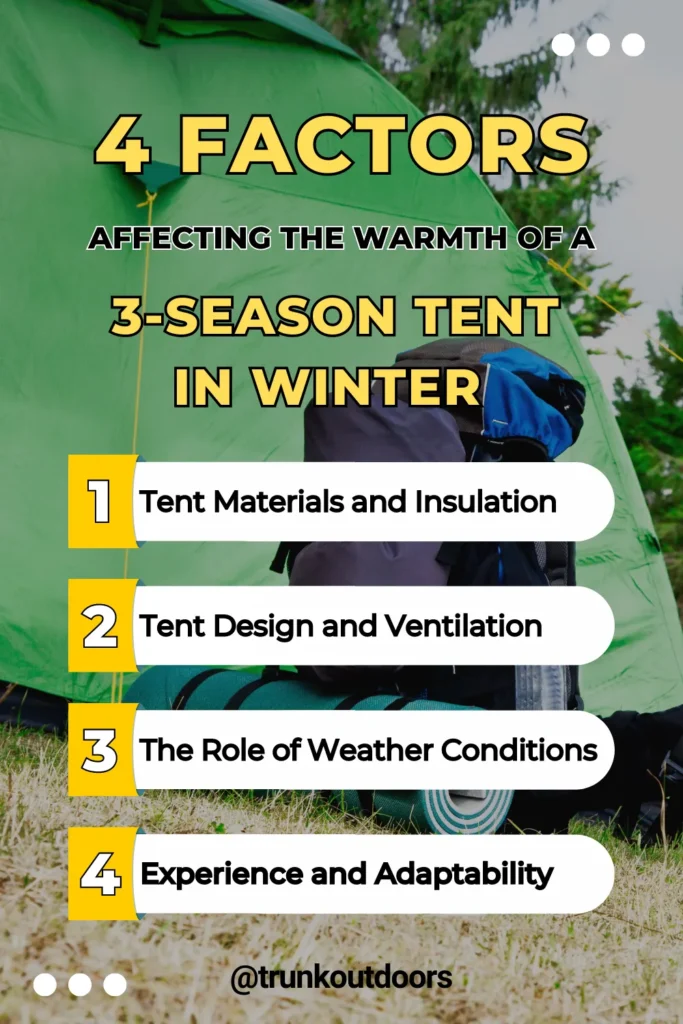How Much Warmer is a 3-Season Tent in Winter?
Planning a winter camping trip? You might have a 3 season tent that works well for most of the year, but you’re probably wondering how does it fare in the winter? How much warmer is a 3-season tent in winter than the outside air?
It’s a valid concern, as staying comfortable and protected from the elements is crucial for an enjoyable outdoor experience.
In this blog post, we’ll answer these questions and more. We’ll look at the factors that influence the warmth of a 3 season tent when the temperatures drop, and how you can improve it with some simple tricks.
Whether you are a beginner or an expert camper, you will find some valuable insights here that help you make an informed decision. So, let’s dive in!
Is a 3-season tent good for winter?
Before we dive into the specifics of winter camping, let’s understand what a 3-season tent is designed for.
These tents are typically built to withstand the conditions of spring, summer, and fall, hence the name. They offer a balance between ventilation and protection from mild weather elements like rain, wind, and moderate temperatures.
However, when winter arrives, temperatures can plummet, and snow and ice become factors to contend with. So, how does a 3-season tent fare in these harsher conditions? Let’s find out!
3-Season vs. 4-Season Tent
When it comes to winter camping, the go-to choice for most adventurers is a 4-season tent. These tents are specifically designed to handle the extreme cold, heavy snow loads, and strong winds that winter brings. They have stronger poles, sturdier fabrics, and less mesh to reduce heat loss.
On the other hand, 3-season tents prioritize breathability and lighter weight, making them ideal for spring, summer, and fall camping.
They usually feature more mesh panels for improved airflow during warmer months. However, this increased ventilation can also mean more heat loss during winter.
So, while a 4-season tent is the ultimate fortress against winter’s fury, 3-season tents can still be a viable option, especially if you plan to camp in milder winter conditions or want a versatile tent that you can use throughout the year.
Overview of Different Types of 3-Season Tents
There are various types of 3-season tents available on the market. Let’s briefly discuss some popular options:
- Dome Tents: Dome tents provide good stability and spacious interiors. They are versatile and suitable for various weather conditions.
- Tunnel Tents: Tunnel tents offer excellent space-to-weight ratios and are known for their aerodynamic shape. They provide good ventilation and are often designed for moderate climates.
- Cabin Tents: Cabin tents are known for their vertical walls and spacious interiors. While they provide ample living space, they may not offer the same level of warmth as other tent types.

Here are some examples of the best 3 season tent for winter camping:
- The MSR Hubba Hubba NX is a lightweight and durable tent that is perfect for backpacking and hiking. It has a spacious interior and good ventilation, making it comfortable to use in a variety of conditions.
- The Nemo Hornet 2P is a lightweight and affordable tent that is perfect for backpacking and hiking. It is compact and easy to set up, and it has good insulation and ventilation.
- The Big Agnes Copper Spur HV UL2 is a high-end tent that is perfect for car camping and backpacking. It is incredibly light and spacious, and it has excellent insulation and ventilation.
- The North Face Talus 3 is a high-end tent that is perfect for car camping and backpacking. It is incredibly warm and comfortable, and it has excellent weatherproofing.
- The MSR Zoid is a durable and spacious tent that is perfect for car camping and backpacking. It has excellent insulation and ventilation, and it can withstand heavy snow and wind.
How Much Warmer is a 3-Season Tent in Winter?
Now, let’s tackle the big question: How much warmer is a 3-season tent in winter? On average, a 3-season tent can offer approximately 5 degrees of additional warmth in winter conditions, but this can vary depending on several factors.

Factors Affecting Warmth in Winter
To determine how much warmer a 3-season tent is in winter, it’s essential to consider several key factors:
1) Tent Materials and Insulation Properties
The materials used in the construction of a 3-season tent can affect its insulation properties. Common tent materials include polyester and nylon.
Polyester is known for its durability and resistance to stretching, while nylon is lightweight and provides excellent water resistance.
Some 3-season tents may also incorporate insulation layers to enhance warmth.
2) Tent Design and Ventilation
The design of a 3-season tent, particularly its ventilation system, plays a significant role in maintaining a comfortable temperature inside.
The mesh panels on the inner layer of the tent promote airflow and reduce condensation.
Proper ventilation helps prevent the buildup of moisture inside the tent, which can make you feel colder.
3) The Role of Weather Conditions
The external weather conditions, including temperature, wind, and precipitation, greatly impact the warmth provided by a 3-season tent.
In milder winter environments with moderate temperatures and calm winds, a well-insulated 3-season tent can offer adequate protection and comfort.
However, in more extreme winter conditions, such as sub-zero temperatures and heavy snowfall, a 3-season tent may not provide sufficient warmth and protection.
4) Experience and Adaptability
Personal experience and adaptability also play significant roles in staying warm in a 3-season tent during winter camping.
With proper preparation and the right gear, it is possible to comfortably sleep in temperatures lower than the rating of your sleeping bag.
Many experienced campers have successfully slept in 35°F weather with a 20°F rated sleeping bag.
While you may feel slightly chilly in colder conditions, you can still manage with the right mindset and preparation.
Read also: How Cold is Too Cold for Camping
Temperature Ratings and Comfort
When considering the warmth of a 3-season tent in winter, it’s essential to understand temperature ratings and comfort levels:
- Understanding Temperature Ratings
Most tents come with temperature ratings that indicate the lowest temperature at which they can provide a comfortable sleeping environment.
These ratings are generally categorized as three-season, four-season, or winter-specific. While 3-season tents have lower temperature ratings compared to summer tents, they are not as insulated as four-season or winter-specific tents.
3-season tents aren’t recommended for use in temperatures below 30 degrees Fahrenheit (-1 degree Celsius). Check our Tips for camping in 30-Degree Weather.
- Comfort vs. Survival Rating
It’s important to distinguish between comfort ratings and survival ratings when assessing a tent’s performance in winter.
Comfort ratings indicate the lowest temperature at which a person can sleep comfortably in the tent, while survival ratings refer to the lowest temperature at which a person can survive in the tent without facing life-threatening conditions.
Keep in mind that comfort ratings may vary between individuals based on their cold tolerance and the gear they use.
How do you insulate a 3-season tent?
To maximize warmth in a 3-season tent during winter camping, consider the following tips:
- Sleeping Bag with High R-Value: Choose a sleeping bag with a high R-value, which indicates its insulation capacity. Opt for a bag rated for colder temperatures than you expect to encounter.
- Sleeping Pad with High R-Value: Insulate yourself from the cold ground by using a sleeping pad with a high R-value. This helps prevent heat loss through conduction.
- Ventilation: While it may seem counterintuitive, proper ventilation is crucial to minimize condensation inside the tent. Adjust the vents and openings to balance airflow and moisture management.
- Stoves: Using a stove inside the tent can provide additional warmth but be cautious of carbon monoxide buildup. Follow safety guidelines and ensure proper ventilation when using a stove indoors.
- Seal any gaps in the tent with duct tape or other weatherproofing materials.
- Wear layers of clothing to bed.
Read more about: How to Dress for Winter Camping?
Using 3-Season Tents in Winter: Dos and Don’ts
To make the most of your 3-season tent in winter, consider the following dos and don’ts:
a) Dos for Using a 3-Season Tent in Winter
- Choose Sheltered Campsites: Look for sheltered areas, such as valleys or wooded areas, to set up your tent. These locations offer natural windbreaks and provide some protection against the elements.
- Properly Stake Down the Tent: Use sturdy tent stakes and guylines to secure your tent to the ground. This helps maintain stability and prevents wind-related issues.
b) Don’ts for Using a 3-Season Tent in Winter
- Exposing the Tent to Extreme Conditions: Avoid subjecting your 3-season tent to extreme winter conditions, such as heavy snowfall or strong winds. It may not withstand these elements and could compromise your safety.
- Neglecting Winter Gear: Using a 3-season tent in winter requires proper gear and preparations. Don’t overlook essential items such as cold-weather sleeping bags, insulation pads, and warm clothing.
FAQs about 3-Season Tents in Winter
-
Can I use a 3-season tent in snowy conditions?
Yes, a 3-season tent can be used in snowy conditions, but it may not provide the same level of insulation as a specialized winter tent. Ensure you have proper sleeping bags, insulation pads, and clothing to stay warm in these conditions.
-
Will condensation be a problem in a 3-season tent during winter?
Condensation can be an issue in cold weather, especially if the tent lacks proper ventilation. Look for tents with adjustable vents or consider using a separate tarp to create a vestibule area for storing wet gear.
-
How do I protect a 3-season tent from heavy snowfall?
To protect a 3-season tent from heavy snow, regularly remove snow buildup from the rainfly and use sturdy tent stakes to anchor the tent securely. Avoid leaving the tent unattended in extreme snow conditions.
-
Can a 3-season tent withstand strong winds in winter?
While 3-season tents are designed to handle moderate wind, they may not provide the same level of stability as winter-specific tents in strong winds. Choose sheltered campsites and properly stake down the tent to minimize wind-related issues.
-
Should I consider a 4-season tent instead?
If you plan to frequently camp in harsh winter conditions or encounter heavy snowfall and strong winds, investing in a 4-season tent or winter-specific tent would be a wise choice. These tents offer enhanced insulation, durability, and stability for extreme weather conditions.
Conclusion
So, how much warmer is a 3-season tent in winter? While it may not offer the same level of warmth and protection as a dedicated 4-season tent, a well-designed and properly set up 3-season tent can still provide a comfortable shelter in milder winter conditions.
Remember to consider the design, materials, insulation, and weather conditions when deciding which tent to use for your winter adventures.
Now that you’re armed with this knowledge, it’s time to plan your winter camping trip and enjoy the beauty of the great outdoors while staying cozy in your 3-season tent!
Join us, and gain exclusive access to expert advice, gear recommendations, and embark on an adventure like never before!